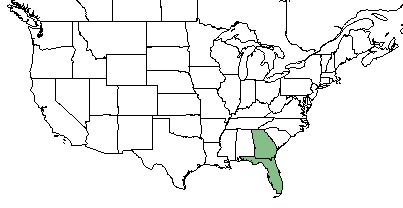Difference between revisions of "Cyrilla parvifolia"
HaleighJoM (talk | contribs) (→Ecology) |
|||
| (One intermediate revision by one other user not shown) | |||
| Line 40: | Line 40: | ||
===Pollination=== | ===Pollination=== | ||
| − | Pollination is primarily performed by Halictid bees. <ref name= "Dute"> Dute, R. R., et al. (2004). "Floral Anatomy and Pollination Biology of | + | Pollination of ''C. racemiflora'' is primarily performed by Halictid bees. <ref name= "Dute"> Dute, R. R., et al. (2004). "Floral Anatomy and Pollination Biology of |
Cyrilla racemiflora (Cyrillaceae)." Southeastern Naturalist: 309-326. </ref> | Cyrilla racemiflora (Cyrillaceae)." Southeastern Naturalist: 309-326. </ref> | ||
| − | <!--=== | + | <!--===Herbivory and toxicology===--> |
<!--==Diseases and parasites==--> | <!--==Diseases and parasites==--> | ||
Latest revision as of 13:47, 22 June 2022
Common names: Littleleaf Titi [1]
| Cyrilla parvifolia | |
|---|---|
| File:Cyrilla parvifolia AFP.jpg | |
| Photo by the Atlas of Florida Plants Database | |
| Scientific classification | |
| Kingdom: | Plantae |
| Division: | Magnoliophyta - Flowering plants |
| Class: | Magnoliopsida - Dicots |
| Order: | Ericales |
| Family: | Cyrillaceae |
| Genus: | Cyrilla |
| Species: | C. parvifolia |
| Binomial name | |
| Cyrilla parvifolia Raf. | |

| |
| Natural range of Cyrilla parvifolia from USDA NRCS Plants Database. | |
Contents
Taxonomic Notes
Synonyms: Cyrilla racemiflora L., C. arida Small.[2]
Varieties: none.[2]
Description
C. parviflora is a perennial shrub/tree of the Cyrillaceae family native to Florida and Georgia.[1]
Distribution
This shrub is particular to Florida and Georgia as its native distribution. [1]
Ecology
Habitat
Common habitats for the C. parvifolia include flatwood pond margins and neighboring drains thorughout the savannas in the Florida, Georgia region. [3] Another possible habitat includes drying ponds. [4]
Phenology
C. racemiflora has been observed to flower between April and November with peak inflorescence in May and June. [5]
Pollination
Pollination of C. racemiflora is primarily performed by Halictid bees. [6]
Conservation, cultivation, and restoration
Cultural use
Photo Gallery
References and notes
- ↑ 1.0 1.1 1.2 USDA Plant Database
- ↑ 2.0 2.1 Weakley, A.S. 2015. Flora of the southern and mid-atlantic states. Working Draft of 21 May 2015. University of North Carolina at Chapel Hill, Chapel Hill, North Carolina.
- ↑ Weakley, A. S. (2015). Flora of the Southern and Mid-Atlantic States. Chapel Hill, NC, University of North Carolina Herbarium.
- ↑ URL: http://herbarium.bio.fsu.edu. Last accessed: June 2018. Collectors: R. Kral. States and counties: Florida in Lake county.
- ↑ Nelson, G. PanFlora: Plant data for the eastern United States with emphasis on the Southeastern Coastal Plains, Florida, and the Florida Panhandle. www.gilnelson.com/PanFlora/ Accessed: 18 MAY 2018
- ↑ Dute, R. R., et al. (2004). "Floral Anatomy and Pollination Biology of Cyrilla racemiflora (Cyrillaceae)." Southeastern Naturalist: 309-326.